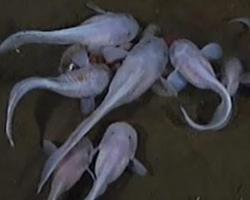
Váhy a míry
| Délka | 30 cm |
|---|
Stav ohrožení
| Ohrožen |
Popis zvířete
The Hadal snailfish, scientifically named Pseudoliparis amblystomopsis, is a remarkable species of deep-sea fish that resides in one of the most extreme environments on Earth. This species is part of the Liparidae family, commonly known as snailfishes. The "Hadal" prefix in its common name refers to its habitat—the hadal zone, which is found in oceanic trenches below depths of 6,000 meters (about 20,000 feet). The hadal zone is known for its high pressure, low temperatures, and complete darkness, conditions that would be inhospitable to most life forms. Yet, the Hadal snailfish has adapted remarkably well to thrive in such an extreme environment.Morphologically, the Hadal snailfish exhibits several features that enable its survival in the deep sea. Its body is small and elongated, typically measuring up to 30 centimeters (about 12 inches) in length, and is characterized by a lack of scales, which gives it a smooth and almost gelatinous appearance. This scaleless skin is thought to be an adaptation to the high-pressure environment, making the fish more flexible and resistant to the crushing forces of the deep sea. The body coloration of Pseudoliparis amblystomopsis is usually a translucent pale to a ghostly white, which provides camouflage in the pitch-black waters it inhabits.
One of the most fascinating aspects of the Hadal snailfish is its physiological adaptations to the extreme conditions of its habitat. It has developed a unique biochemistry that allows its cellular membranes to remain fluid and functional under high pressure and low temperatures. This includes the presence of special proteins and enzymes that are adapted to function optimally in such conditions, as well as antifreeze compounds in its blood to prevent ice crystal formation.
The diet of the Hadal snailfish primarily consists of small crustaceans, amphipods, and other invertebrates it finds on the ocean floor. Its feeding strategy is opportunistic, relying on the scarce food resources available in the deep-sea environment. The lack of light in its habitat means that the Hadal snailfish does not rely on vision for hunting; instead, it is believed to use its highly sensitive lateral line system to detect the movements of prey in the darkness.
Reproduction in Pseudoliparis amblystomopsis, like many aspects of its biology, is not well understood due to the difficulty of studying these creatures in their natural habitat. However, it is thought that they lay eggs, which are likely guarded by one of the parents until they hatch, a behavior observed in some related species.
The Hadal snailfish's ability to live in the deepest parts of the ocean makes it a subject of great interest among scientists. Studying this species can provide insights into the limits of life on Earth and the adaptations necessary to survive in extreme environments. Additionally, understanding how organisms like the Hadal snailfish cope with high pressure and low temperatures could have implications for biotechnology and medicine, offering potential applications in areas such as enzyme development and preservation techniques.
Despite its fascinating biology, the Hadal snailfish remains a mysterious creature, with much about its lifestyle and ecology still to be discovered. Its existence challenges our understanding of life's boundaries and serves as a reminder of the incredible diversity and resilience of life on our planet.
Nové fotografie zvířat
Top 10 zvířat
- Chinese water dragon (Physignathus cocincinus)
- Galápagos tortoise (Geochelone nigra complex)
- Dolphin gull (Leucophaeus scoresbii)
- Japanese macaque (Macaca fuscata)
- Colombian red howler (Alouatta seniculus)
- Sea urchins (Echinoidea)
- Moustached guenon (Cercopithecus cephus)
- Diana monkey (Cercopithecus diana)
- Common reed warbler (Acrocephalus scirpaceus)
- Common house mosquito (Culex pipiens)